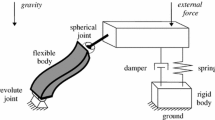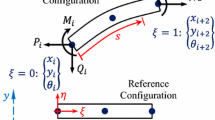Abstract
This study thoroughly examines various higher-order three and four-node beam elements for use in the absolute nodal coordinate formulation (ANCF). The paper carefully investigates which potential benefits and drawbacks the utilization of higher-order ANCF beam elements without in-slope vectors has in the case of the usage of full three-dimensional elasticity. When the elastic forces for shear-deformable ANCF beam elements are calculated using full three-dimensional elasticity—especially in the form of the St. Venant–Kirchhoff material law—Poisson locking severely deteriorates the accuracy of the numeric results. As shown in this paper, an existing approach to preventing this locking phenomenon for three-node beam elements can still produce unsatisfying results in load cases involving bidirectional bending. The results of this study show that enriching the polynomial basis used to approximate the beam kinematics provides a natural solution to this issue. As will be seen, these findings for three-node elements can also be extended to four-node elements. When using a sufficient approximation order in transverse directions, satisfying accuracy can be achieved both in conventional one-dimensional bending and in the above-mentioned bidirectional load case.










Similar content being viewed by others
References
Bauchau, O.A., Han, S., Mikkola, A., Matikainen, M.K., Gruber, P.: Experimental validation of flexible multibody dynamics beam formulations. Multibody Syst. Dyn. 34(4), 373–389 (2015)
Dmitrochenko, O., Mikkola, A.: Digital nomenclature code for topology and kinematics of finite elements based on the absolute nodal co-ordinate formulation. Proc. Inst. Mech. Eng., Part K: J. Multi-Body Dyn. 225(1), 34–51 (2011)
Dufva, K.E., Sopanen, J.T., Mikkola, A.M.: A two-dimensional shear deformable beam element based on the absolute nodal coordinate formulation. J. Sound Vib. 280(3), 719–738 (2005)
Dowell, E.H., Traybar, J.J.: An addendum to AMS report no 1194 entitled an experimental study of the nonlinear stiffness of a rotor blade undergoing flap, lag, and twist deformations. Technical Report 1257, AMS Report, December (1975)
Dowell, E.H., Traybar, J.J.: An experimental study of the nonlinear stiffness of a rotor blade undergoing flap, lag and twist deformations. Technical Report 1194, AMS Report, January (1975)
Gerstmayr, J., Matikainen, M.K.: Analysis of stress and strain in the absolute nodal coordinate formulation. Mech. Based Des. Struct. Mach. 34(4), 409–430 (2006)
Gerstmayr, J., Matikainen, M.K., Mikkola, A.M.: A geometrically exact beam element based on the absolute nodal coordinate formulation. Multibody Syst. Dyn. 20(4), 359–384 (2008)
Gerstmayr, J., Shabana, A.A.: Efficient integration of the elastic forces and thin three-dimensional beam elements in the absolute nodal coordinate formulation. In: Multibody Dynamics 2005, ECCOMAS Thematic Conference, Madrid, Spain, 21–24 June 2005
Gerstmayr, J., Shabana, A.A.: Analysis of thin beams and cables using the absolute nodal co-ordinate formulation. Nonlinear Dyn. 45(1), 109–130 (2006)
Humer, A.: Dynamic modeling of beams with non-material, deformation-dependent boundary conditions. J. Sound Vib. 332(3), 622–641 (2013)
Kerkkänen, K.S., García-Vallejo, D., Mikkola, A.M.: Modeling of belt-drives using a large deformation finite element formulation. Nonlinear Dyn. 43(3), 239–256 (2006)
Matikainen, M.K., Dmitrochenko, O.: A study of three-node higher-order gradient beam elements based on the absolute nodal coordinate formulation. In: The 3rd Joint International Conference on Multibody System Dynamics, Busan, Korea (2014)
Matikainen, M.K., Dmitrochenko, O., Mikkola, A.: Beam elements with trapezoidal cross section deformation modes based on the absolute nodal coordinate formulation. In International Conference of Numerical Analysis and Applied Mathematics, Rhodes, Greece, 19–25 Sept 2010
Matikainen, M.K., Dmitrochenko, O., Mikkola, A.: Higher order beam elements based on the absolute nodal coordinate formulation. In: Multibody Dynamics 2011, ECCOMAS Thematic Conference, 4–7 July 2011
Matikainen, M.K., Dmitrochenko, O., Mikkola, A.: Higher order beam elements based on the absolute nodal coordinate formulation. Multibody Dynamics (2011)
Matikainen, M.K., Valkeapää, A.I., Mikkola, A.M., Schwab, A.L.: A study of moderately thick quadrilateral plate elements based on the absolute nodal coordinate formulation. Multibody Syst. Dyn. 31(3), 309–338 (2014)
Nachbagauer, K., Gruber, P., Gerstmayr, J.: A 3d shear deformable finite element based on the absolute nodal coordinate formulation. In: Samin, Jean-Claude, Fisette, Paul (eds.) Multibody Dynamics. Computational Methods in Applied Sciences, vol. 28, pp. 77–96. Springer, Netherlands (2013)
Olshevskiy, A., Dmitrochenko, O., Kim, C.-W.: Three-dimensional solid brick element using slopes in the absolute nodal coordinate formulation. J. Comput. Nonlinear Dyn. 9(2), 021001 (2014)
Orzechowski, G., Fraczek, J.: Nearly incompressible nonlinear material models in the large deformation analysis of beams using ANCF. Nonlinear Dyn. 82(1), 451–464 (2015)
Orzechowski, G., Shabana, A.A.: Analysis of warping deformation modes using higher order ANCF beam element. J. Sound Vib. 363, 428–445 (2016)
Shabana, A.A.: Definition of the slopes and the finite element absolute nodal coordinate formulation. Multibody Syst. Dyn. 1, 339–348 (1997)
Shen, Z., Li, P., Liu, C., Hu, G.: A finite element beam model including cross-section distortion in the absolute nodal coordinate formulation. Nonlinear Dyn. 77(3), 1019–1033 (2014)
Sugiyama, H., Mikkola, A.M., Shabana, A.A.: A non-incremental nonlinear finite element solution for cable problems. In: ASME 2003 International Design Engineering Technical Conferences and Computers and Information in Engineering Conference, pp. 171–181. American Society of Mechanical Engineers (2003)
Valkeapää, A.I., Matikainen, M.K., Mikkola, A.M.: Meshing strategies in the absolute nodal coordinate formulation-based Euler-Bernoulli beam elements. Proc. Inst. Mech. Eng., Part K: J. Multi-Body Dyn. 230(4), 606–614 (2016)
Wang, C.M., Reddy, J.N., Lee, K.H.: Shear Deformable Beams and Plates. Elsevier, Amsterdam (2000)
Acknowledgements
The authors would like to thank the Academy of Finland (Application No. 259543 for the funding of Postdoctoral Researchers and Application No. 285064) for supporting Marko K. Matikainen.
Author information
Authors and Affiliations
Corresponding author
Rights and permissions
About this article
Cite this article
Ebel, H., Matikainen, M.K., Hurskainen, VV. et al. Higher-order beam elements based on the absolute nodal coordinate formulation for three-dimensional elasticity. Nonlinear Dyn 88, 1075–1091 (2017). https://doi.org/10.1007/s11071-016-3296-x
Received:
Accepted:
Published:
Issue Date:
DOI: https://doi.org/10.1007/s11071-016-3296-x




